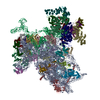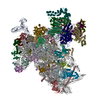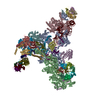[English] 日本語
 Yorodumi
Yorodumi- PDB-6w2s: Structure of the Cricket Paralysis Virus 5-UTR IRES (CrPV 5-UTR-I... -
+ Open data
Open data
- Basic information
Basic information
| Entry | Database: PDB / ID: 6w2s | ||||||
|---|---|---|---|---|---|---|---|
| Title | Structure of the Cricket Paralysis Virus 5-UTR IRES (CrPV 5-UTR-IRES) bound to the small ribosomal subunit in the open state (Class 1) | ||||||
 Components Components |
| ||||||
 Keywords Keywords | Ribosome/TRANSLATION / CrPV 5'-UTR IRES /  Internal ribosome entry site / Internal ribosome entry site /  RIBOSOME / Ribosome-TRANSLATION complex RIBOSOME / Ribosome-TRANSLATION complex | ||||||
| Function / homology |  Function and homology information Function and homology informationviral translational termination-reinitiation / eukaryotic translation initiation factor 3 complex, eIF3e / eukaryotic translation initiation factor 3 complex, eIF3m / IRES-dependent viral translational initiation / eukaryotic translation initiation factor 3 complex / eukaryotic 43S preinitiation complex / formation of cytoplasmic translation initiation complex / eukaryotic 48S preinitiation complex /  ribosomal subunit / metal-dependent deubiquitinase activity ...viral translational termination-reinitiation / eukaryotic translation initiation factor 3 complex, eIF3e / eukaryotic translation initiation factor 3 complex, eIF3m / IRES-dependent viral translational initiation / eukaryotic translation initiation factor 3 complex / eukaryotic 43S preinitiation complex / formation of cytoplasmic translation initiation complex / eukaryotic 48S preinitiation complex / ribosomal subunit / metal-dependent deubiquitinase activity ...viral translational termination-reinitiation / eukaryotic translation initiation factor 3 complex, eIF3e / eukaryotic translation initiation factor 3 complex, eIF3m / IRES-dependent viral translational initiation / eukaryotic translation initiation factor 3 complex / eukaryotic 43S preinitiation complex / formation of cytoplasmic translation initiation complex / eukaryotic 48S preinitiation complex /  ribosomal subunit / metal-dependent deubiquitinase activity / regulation of translational initiation / nuclear-transcribed mRNA catabolic process, nonsense-mediated decay / ribosomal subunit / metal-dependent deubiquitinase activity / regulation of translational initiation / nuclear-transcribed mRNA catabolic process, nonsense-mediated decay /  translation initiation factor binding / translation initiation factor binding /  translation initiation factor activity / translation initiation factor activity /  DNA-(apurinic or apyrimidinic site) lyase / positive regulation of translation / PML body / DNA-(apurinic or apyrimidinic site) lyase / positive regulation of translation / PML body /  fibrillar center / fibrillar center /  metallopeptidase activity / metallopeptidase activity /  ribosome binding / cysteine-type deubiquitinase activity / ribosome binding / cysteine-type deubiquitinase activity /  postsynaptic density / structural constituent of ribosome / postsynaptic density / structural constituent of ribosome /  translation / translation /  synapse / synapse /  nucleolus / nucleolus /  RNA binding / RNA binding /  nucleoplasm / identical protein binding / nucleoplasm / identical protein binding /  nucleus / nucleus /  cytosol cytosolSimilarity search - Function | ||||||
| Biological species |   Cricket paralysis virus Cricket paralysis virus  Oryctolagus cuniculus (rabbit) Oryctolagus cuniculus (rabbit) | ||||||
| Method |  ELECTRON MICROSCOPY / ELECTRON MICROSCOPY /  single particle reconstruction / single particle reconstruction /  cryo EM / Resolution: 3.47 Å cryo EM / Resolution: 3.47 Å | ||||||
 Authors Authors | Neupane, R. / Pisareva, V. / Rodriguez, C.F. / Pisarev, A. / Fernandez, I.S. | ||||||
| Funding support |  United States, 1items United States, 1items
| ||||||
 Citation Citation |  Journal: Elife / Year: 2020 Journal: Elife / Year: 2020Title: A complex IRES at the 5'-UTR of a viral mRNA assembles a functional 48S complex via an uAUG intermediate. Authors: Ritam Neupane / Vera P Pisareva / Carlos F Rodriguez / Andrey V Pisarev / Israel S Fernández /   Abstract: Taking control of the cellular apparatus for protein production is a requirement for virus progression. To ensure this control, diverse strategies of cellular mimicry and/or ribosome hijacking have ...Taking control of the cellular apparatus for protein production is a requirement for virus progression. To ensure this control, diverse strategies of cellular mimicry and/or ribosome hijacking have evolved. The initiation stage of translation is especially targeted as it involves multiple steps and the engagement of numerous initiation factors. The use of structured RNA sequences, called nternal ibosomal ntry ites (IRES), in viral RNAs is a widespread strategy for the exploitation of eukaryotic initiation. Using a combination of electron cryo-microscopy (cryo-EM) and reconstituted translation initiation assays with native components, we characterized how a novel IRES at the 5'-UTR of a viral RNA assembles a functional initiation complex via an uAUG intermediate. The IRES features a novel extended, multi-domain architecture, that circles the 40S head. The structures and accompanying functional data illustrate the importance of 5'-UTR regions in translation regulation and underline the relevance of the untapped diversity of viral IRESs. | ||||||
| History |
|
- Structure visualization
Structure visualization
| Movie |
 Movie viewer Movie viewer |
|---|---|
| Structure viewer | Molecule:  Molmil Molmil Jmol/JSmol Jmol/JSmol |
- Downloads & links
Downloads & links
- Download
Download
| PDBx/mmCIF format |  6w2s.cif.gz 6w2s.cif.gz | 2.6 MB | Display |  PDBx/mmCIF format PDBx/mmCIF format |
|---|---|---|---|---|
| PDB format |  pdb6w2s.ent.gz pdb6w2s.ent.gz | Display |  PDB format PDB format | |
| PDBx/mmJSON format |  6w2s.json.gz 6w2s.json.gz | Tree view |  PDBx/mmJSON format PDBx/mmJSON format | |
| Others |  Other downloads Other downloads |
-Validation report
| Arichive directory |  https://data.pdbj.org/pub/pdb/validation_reports/w2/6w2s https://data.pdbj.org/pub/pdb/validation_reports/w2/6w2s ftp://data.pdbj.org/pub/pdb/validation_reports/w2/6w2s ftp://data.pdbj.org/pub/pdb/validation_reports/w2/6w2s | HTTPS FTP |
|---|
-Related structure data
| Related structure data |  21529MC  6w2tC M: map data used to model this data C: citing same article ( |
|---|---|
| Similar structure data |
- Links
Links
- Assembly
Assembly
| Deposited unit | 
|
|---|---|
| 1 |
|
- Components
Components
-RNA chain , 2 types, 2 molecules A0
| #1: RNA chain |  18S ribosomal RNA 18S ribosomal RNAMass: 547733.062 Da / Num. of mol.: 1 / Source method: isolated from a natural source / Source: (natural)   Oryctolagus cuniculus (rabbit) Oryctolagus cuniculus (rabbit) |
|---|---|
| #2: RNA chain | Mass: 121094.953 Da / Num. of mol.: 1 Source method: isolated from a genetically manipulated source Source: (gene. exp.)   Cricket paralysis virus / Production host: Cricket paralysis virus / Production host:   Escherichia coli (E. coli) / References: Escherichia coli (E. coli) / References:  GenBank: 8895506 GenBank: 8895506 |
+Protein , 33 types, 33 molecules BCDFHIJKMOPWXYZbcfEGLNQRSTUVad...
-Eukaryotic translation initiation factor 3 subunit ... , 8 types, 8 molecules 12345678
| #36: Protein |  Eukaryotic initiation factor 3 / eIF3a / Eukaryotic translation initiation factor 3 subunit 10 / eIF-3-theta Eukaryotic initiation factor 3 / eIF3a / Eukaryotic translation initiation factor 3 subunit 10 / eIF-3-thetaMass: 164902.656 Da / Num. of mol.: 1 / Source method: isolated from a natural source / Source: (natural)   Oryctolagus cuniculus (rabbit) / References: UniProt: G1SMZ5 Oryctolagus cuniculus (rabbit) / References: UniProt: G1SMZ5 |
|---|---|
| #37: Protein |  Eukaryotic initiation factor 3 / eIF3c / Eukaryotic translation initiation factor 3 subunit 8 / eIF3 p110 Eukaryotic initiation factor 3 / eIF3c / Eukaryotic translation initiation factor 3 subunit 8 / eIF3 p110Mass: 105706.156 Da / Num. of mol.: 1 / Source method: isolated from a natural source / Source: (natural)   Oryctolagus cuniculus (rabbit) / References: UniProt: G1U971 Oryctolagus cuniculus (rabbit) / References: UniProt: G1U971 |
| #38: Protein |  Eukaryotic initiation factor 3 / eIF3e / Eukaryotic translation initiation factor 3 subunit 6 / eIF-3 p48 Eukaryotic initiation factor 3 / eIF3e / Eukaryotic translation initiation factor 3 subunit 6 / eIF-3 p48Mass: 54199.863 Da / Num. of mol.: 1 / Source method: isolated from a natural source / Source: (natural)   Oryctolagus cuniculus (rabbit) / References: UniProt: G1SUC8 Oryctolagus cuniculus (rabbit) / References: UniProt: G1SUC8 |
| #39: Protein |  Eukaryotic initiation factor 3 / eIF3f / Eukaryotic translation initiation factor 3 subunit 5 / eIF-3-epsilon / eIF3 p47 Eukaryotic initiation factor 3 / eIF3f / Eukaryotic translation initiation factor 3 subunit 5 / eIF-3-epsilon / eIF3 p47Mass: 37846.730 Da / Num. of mol.: 1 / Source method: isolated from a natural source / Source: (natural)   Oryctolagus cuniculus (rabbit) / References: UniProt: G1SLC2 Oryctolagus cuniculus (rabbit) / References: UniProt: G1SLC2 |
| #40: Protein |  Eukaryotic initiation factor 3 / eIF3h / Eukaryotic translation initiation factor 3 subunit 3 / eIF-3 gamma / eIF3 p40 subunit Eukaryotic initiation factor 3 / eIF3h / Eukaryotic translation initiation factor 3 subunit 3 / eIF-3 gamma / eIF3 p40 subunitMass: 41083.531 Da / Num. of mol.: 1 / Source method: isolated from a natural source / Source: (natural)   Oryctolagus cuniculus (rabbit) / References: UniProt: G1ST95 Oryctolagus cuniculus (rabbit) / References: UniProt: G1ST95 |
| #41: Protein |  Eukaryotic initiation factor 3 / eIF3k / Eukaryotic translation initiation factor 3 subunit 12 / eIF-3 p25 Eukaryotic initiation factor 3 / eIF3k / Eukaryotic translation initiation factor 3 subunit 12 / eIF-3 p25Mass: 25129.709 Da / Num. of mol.: 1 / Source method: isolated from a natural source / Source: (natural)   Oryctolagus cuniculus (rabbit) / References: UniProt: G1T3L2 Oryctolagus cuniculus (rabbit) / References: UniProt: G1T3L2 |
| #42: Protein |  Eukaryotic initiation factor 3 / eIF3l / Eukaryotic translation initiation factor 3 subunit 6-interacting protein / Eukaryotic ...eIF3l / Eukaryotic translation initiation factor 3 subunit 6-interacting protein / Eukaryotic translation initiation factor 3 subunit E-interacting protein Eukaryotic initiation factor 3 / eIF3l / Eukaryotic translation initiation factor 3 subunit 6-interacting protein / Eukaryotic ...eIF3l / Eukaryotic translation initiation factor 3 subunit 6-interacting protein / Eukaryotic translation initiation factor 3 subunit E-interacting proteinMass: 71001.477 Da / Num. of mol.: 1 / Source method: isolated from a natural source / Source: (natural)   Oryctolagus cuniculus (rabbit) / References: UniProt: G1SED9 Oryctolagus cuniculus (rabbit) / References: UniProt: G1SED9 |
| #43: Protein |  Eukaryotic initiation factor 3 / eIF3m Eukaryotic initiation factor 3 / eIF3mMass: 42555.832 Da / Num. of mol.: 1 / Source method: isolated from a natural source / Source: (natural)   Oryctolagus cuniculus (rabbit) / References: UniProt: G1SLW8 Oryctolagus cuniculus (rabbit) / References: UniProt: G1SLW8 |
-Non-polymers , 2 types, 2 molecules 


| #44: Chemical | ChemComp-MG / |
|---|---|
| #45: Chemical | ChemComp-ZN / |
-Details
| Has ligand of interest | N |
|---|
-Experimental details
-Experiment
| Experiment | Method:  ELECTRON MICROSCOPY ELECTRON MICROSCOPY |
|---|---|
| EM experiment | Aggregation state: PARTICLE / 3D reconstruction method:  single particle reconstruction single particle reconstruction |
- Sample preparation
Sample preparation
| Component | Name: Structure of the Cricket Paralysis Virus 5-UTR IRES (CrPV 5-UTR-IRES) bound to the small ribosomal subunit in the open state (Class 1) Type: RIBOSOME / Entity ID: #1-#43 / Source: MULTIPLE SOURCES |
|---|---|
| Molecular weight | Experimental value: NO |
| Source (natural) | Organism:   Oryctolagus cuniculus (rabbit) Oryctolagus cuniculus (rabbit) |
| Buffer solution | pH: 7.5 |
| Specimen | Embedding applied: NO / Shadowing applied: NO / Staining applied : NO / Vitrification applied : NO / Vitrification applied : YES : YES |
| Specimen support | Grid material: GOLD / Grid mesh size: 300 divisions/in. / Grid type: Quantifoil, UltrAuFoil, R1.2/1.3 |
Vitrification | Instrument: FEI VITROBOT MARK IV / Cryogen name: ETHANE / Humidity: 100 % / Chamber temperature: 277.15 K Details: Grids were blotted for 2.5s and flash cooled in liquid ethane |
- Electron microscopy imaging
Electron microscopy imaging
| Experimental equipment |  Model: Titan Krios / Image courtesy: FEI Company |
|---|---|
| Microscopy | Model: FEI TITAN KRIOS |
| Electron gun | Electron source : :  FIELD EMISSION GUN / Accelerating voltage: 300 kV / Illumination mode: FLOOD BEAM FIELD EMISSION GUN / Accelerating voltage: 300 kV / Illumination mode: FLOOD BEAM |
| Electron lens | Mode: BRIGHT FIELD Bright-field microscopy Bright-field microscopy |
| Image recording | Average exposure time: 8 sec. / Electron dose: 56.9 e/Å2 / Detector mode: COUNTING / Film or detector model: GATAN K2 SUMMIT (4k x 4k) / Num. of grids imaged: 1 |
| Image scans | Movie frames/image: 40 / Used frames/image: 1-40 |
- Processing
Processing
| Software | Name: REFMAC / Version: 5.8.0253 / Classification: refinement | ||||||||||||||||||||||||||||||||||||||||||||||||||||||||||||||||||||||||||||||||||||||||||||||||||||||||||
|---|---|---|---|---|---|---|---|---|---|---|---|---|---|---|---|---|---|---|---|---|---|---|---|---|---|---|---|---|---|---|---|---|---|---|---|---|---|---|---|---|---|---|---|---|---|---|---|---|---|---|---|---|---|---|---|---|---|---|---|---|---|---|---|---|---|---|---|---|---|---|---|---|---|---|---|---|---|---|---|---|---|---|---|---|---|---|---|---|---|---|---|---|---|---|---|---|---|---|---|---|---|---|---|---|---|---|---|
| EM software |
| ||||||||||||||||||||||||||||||||||||||||||||||||||||||||||||||||||||||||||||||||||||||||||||||||||||||||||
| Image processing | Details: The microscope was equipped with an energy filter with slits aperture of 20eV, installed before the detector. | ||||||||||||||||||||||||||||||||||||||||||||||||||||||||||||||||||||||||||||||||||||||||||||||||||||||||||
CTF correction | Type: PHASE FLIPPING AND AMPLITUDE CORRECTION | ||||||||||||||||||||||||||||||||||||||||||||||||||||||||||||||||||||||||||||||||||||||||||||||||||||||||||
| Particle selection | Num. of particles selected: 915647 | ||||||||||||||||||||||||||||||||||||||||||||||||||||||||||||||||||||||||||||||||||||||||||||||||||||||||||
| Symmetry | Point symmetry : C1 (asymmetric) : C1 (asymmetric) | ||||||||||||||||||||||||||||||||||||||||||||||||||||||||||||||||||||||||||||||||||||||||||||||||||||||||||
3D reconstruction | Resolution: 3.47 Å / Resolution method: FSC 0.143 CUT-OFF / Num. of particles: 36100 / Num. of class averages: 1 / Symmetry type: POINT | ||||||||||||||||||||||||||||||||||||||||||||||||||||||||||||||||||||||||||||||||||||||||||||||||||||||||||
| Refinement | Resolution: 3.47→3.47 Å / Cor.coef. Fo:Fc: 0.843 / SU B: 20.39 / SU ML: 0.323 / ESU R: 0.367 Stereochemistry target values: MAXIMUM LIKELIHOOD WITH PHASES Details: HYDROGENS HAVE BEEN ADDED IN THE RIDING POSITIONS
| ||||||||||||||||||||||||||||||||||||||||||||||||||||||||||||||||||||||||||||||||||||||||||||||||||||||||||
| Solvent computation | Ion probe radii: 0.8 Å / Shrinkage radii: 0.8 Å / VDW probe radii: 1.2 Å / Solvent model: MASK | ||||||||||||||||||||||||||||||||||||||||||||||||||||||||||||||||||||||||||||||||||||||||||||||||||||||||||
| Displacement parameters | Biso mean: 120.284 Å2
| ||||||||||||||||||||||||||||||||||||||||||||||||||||||||||||||||||||||||||||||||||||||||||||||||||||||||||
| Refinement step | Cycle: 1 / Total: 106817 | ||||||||||||||||||||||||||||||||||||||||||||||||||||||||||||||||||||||||||||||||||||||||||||||||||||||||||
| Refine LS restraints |
|
 Movie
Movie Controller
Controller












 PDBj
PDBj
































